Matador Network's Blog, page 876
April 21, 2020
Creepiest object Twitter contest
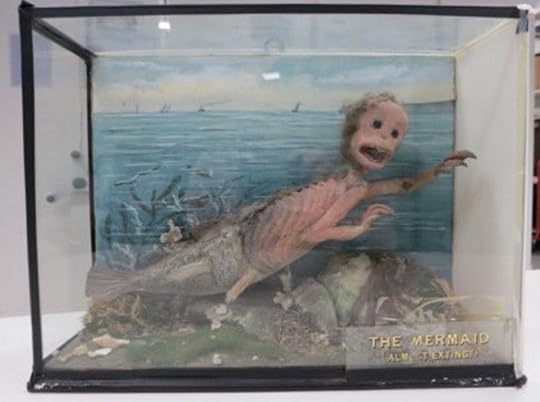
Most museums around the world are closed to visitors, but curators are finding creative ways to engage and educate the masses.
The Yorkshire Museum in York, England, started a Twitter battle over which museum has the creepiest object and called on curators from around the world to post their photos for everyone to see.
It kicked off the competition by posting a photo of a hair bun from a Roman woman’s burial in the third or fourth century, with hair clips still in place.
MUSEUMS ASSEMBLE! It's time for #CURATORBATTLE!
April 20, 2020
The world’s best drag queens
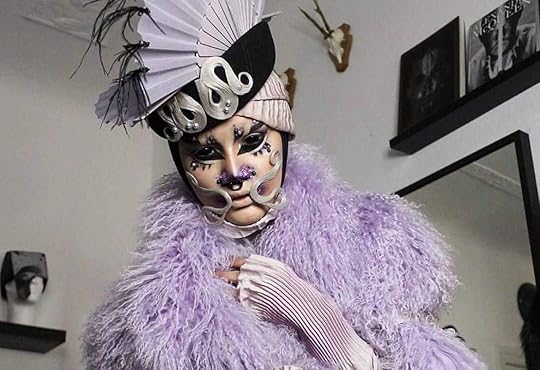
RuPaul’s Drag Race has transformed drag culture from niche gay-bar entertainment to popular mainstream commodity since first airing on LogoTV in 2009. As a result, many of the queens who sashay down Ru’s runway find international fame and enjoy the kind of monetary stability their industry predecessors never dreamed of 10 years ago.
But when it comes to noteworthy drag, these queens aren’t always the be all end all; Ru’s army of reality-tv mother-tuckers is only a fraction of the fabulously diverse drag ecosystem found around the world. Missing from this legacy of ladies in lace-fronts are drag kings, queens living outside the United States, and well-respected artists who were hustling in heels long before many of Mama Ru’s drag babies were a twinkle in her eye.
So instead of gagging over yet another conglomerate of creatives competing to become America’s next drag superstar, we’re celebrating a crew of crown-worthy gender-benders you won’t find lip-syncing on VH1.
Here’s a list of drag queens worth knowing and where to watch them perform.
1. Hungry — Berlin, Germany
View this post on InstagramA post shared by Hungry (@isshehungry) on Mar 8, 2020 at 2:48pm PDT
Hungry, a Berlin-based performer, designer, and makeup artist exploded on the drag scene after painting Icelandic singer Bjork’s mug for her 2017 music album Utopia. The artist’s self-named “distorted drag” brings to mind an Alexander McQueen runway look that was abducted by aliens and sent back down to Earth just in time for Paris Fashion Week.
Although Berlin’s drag scene might not support as robust of a community as cities like New York or London, Hungry is part of a subculture characterized by avant-garde artists who think outside the box and reach far past gay bars for their fan base. Hungry has performed at Berlin’s Traumabar und Kino, an art space with live performances, and alongside Sasha Velour, a Drag Race winner known for her experimental performance style.
2. Peaches Christ — San Francisco, California
View this post on InstagramA post shared by Peaches Christ (@thepeacheschrist) on Jan 28, 2020 at 12:50pm PST
This silver-screen scream queen was American drag royalty long before RuPaul started handing out crowns on LogoTV. After beelining to San Francisco in the 1990s, Peaches Christ (the alter ego of Joshua Grannell) made a name for herself as a drag performer and emcee. In 2010, Grannell directed the farcical D-list cult film All About Evil, starring Natasha Lyonne. Today, you can find Peaches performing alongside the likes of BenDeLaCreme, Jinx Monsoon, and SF legend Heklina in Drag Becomes Her, a send-up of the Meryl Streep/Goldie Hawn film Death Becomes Her.
Parodies are indeed this queen’s bread and butter. From Legally Black and Mean Gays to Steel Dragnolias and First Wives Fight Club, Peaches Christ is an expert at injecting queer movie classics with an extra-large helping of camp. Catch the queen in action at the iconic Castro Theater in San Francisco.
3. Queef Latina — Miami, Florida
View this post on InstagramA post shared by Queef Latina (@queef.latina) on Feb 25, 2020 at 6:15am PST
Queef Latina serves up Florida femininity with a masculine twist: She’s a South Beach Stepford wife from the back, but with a beard that won’t quit and enough chest hair to knit a baby blanket, she’s continually giving gender norms the proverbial middle finger.
Looks aside, Queef Latina is more of a warm hug than a middle finger. In 2017, this Miami native founded Wigwood — an all-inclusive queer arts festival in February that has put Miami’s blossoming drag scene on the map. She also hosts sewing classes at the Hotel Gaythering where homos (and those who love them) can hone their skills while making fanny packs, jockstraps, tote bags, and harnesses. It’s clear why she was named Miami New Times’ Best Drag Performer of the Year in 2019 — she’s a badass lady boss bringing modern sensibilities to old artforms.
4. Landon Cider — Los Angeles, California
View this post on InstagramA post shared by Landon Cider DragKing (@landoncider) on Feb 28, 2020 at 10:37am PST
In 2019, Landon Cider rose to the top of his field when he became the first drag king in history to win Dragula, a horror-drag reality tv competition hosted by The Boulet Brothers. Unlike RuPaul’s Drag Race, which excludes drag kings from participating, Dragula‘s platform gave Cider the chance to show his skill at manipulating makeup and costumes to create mind-boggling physical transformations.
Cider’s name recognition among drag aficionados is helping create awareness for women working in an otherwise male-dominated field. In addition to performing in Los Angeles, his hometown, Cider has recently played international cities like Berlin, Manchester, Amsterdam, Paris, and Miami.
5. Shequida Hall — New York, New York
View this post on InstagramA post shared by Shequida Hall (@shequidahall) on Jan 2, 2020 at 11:08am PST
In a profession where most performers live and die by lip-syncing, Shequida Hall is a breath of fresh air. On top of being an accomplished film and stage actress, Hall is a classically trained opera singer with a soaring soprano capable of cutting through even the noisiest New York City bar. It isn’t only a might tuck that’s helping her hit those high notes, either. Shequida has got the training to back it up and a degree from Juilliard to prove it.
Singing aside, this Jamaica-born drag queen is a star of the drag scene because of her witty banter as a cabaret host. She emcees Bartschland Follies, a Friday night variety show at Manhattan’s McKittrick Hotel, and also makes appearances at Pieces in the West Village and Hardware Bar in Hell’s Kitchen.
6. Cheddar Gorgeous — Manchester, United Kingdom
View this post on InstagramA post shared by Cheddar Gorgeous (@cheddar_gorgeous) on Jan 27, 2020 at 1:14pm PST
Cheddar Gorgeous, the bald beauty of Manchester’s queer nightlife scene, is a sci-fi shapeshifter with a range spanning from Elizabethan burlesque to club-kid unicorn. One look at her Instagram account proves her array of genderqueer drag looks are as versatile as David Bowie’s career and more polished than the queen’s royal jewels. She’s also one of the hosts of Drag SOS, a UK-based show that follows the Family Gorgeous as they traipse around England and turn unlikely candidates into full-fledged drag divas.
With a Ph.D. in social anthropology, Cheddar recognizes her drag persona has power outside the entertainment world, too. In 2018, she organized a Trump protest in London, garnering tons of media attention. Her use of drag as a political platform brings to mind the great queens who went to battle for gay rights at Stonewall over 50 years ago, and her creativity eclipses many of the folks working in the industry today.
Cheddar is the self-proclaimed “drag daddy” of Manchester’s queer performance show Cha Cha Boudoir and often burns up the floor at the late-night dance party Aftershock.
7. Jackie Beat — Los Angeles, California
View this post on InstagramA post shared by Jackie Beat (@jackiebeat) on Jan 31, 2020 at 6:31pm PST
Los Angeles may be home to more Drag Race contestants than you can count on all your acrylic nails, but most play second fiddle to Jackie Beat, a West Coast comedy queen whose sharp tongue and silver voice have endeared her to queer audiences for a quarter-century. Like a Weird Al Yankovic with hair that’s bigger than Texas, Jackie is best known for her quirky parodies of pop hits by gay icons like Cher, Madonna, and Lady Gaga. On top of performing, she’s been a writer for personalities like Joan Rivers, Ross Matthews, and Roseanne Barr.
Jackie Beat is an old-school queen. Much like Coco Peru, Sherry Vine, and Lady Bunny, she came of age long before RuPaul inspired an entire generation of performers, and she’s still hustling harder than most. Although LA is Jackie’s home base (you can often find her at Hamburger Mary’s), she’s an international icon who treads the biggest drag boards around North America and Europe.
8. Dina Martina — Provincetown, Massachusetts & Seattle, Washington
View this post on InstagramA post shared by Dina Martina (@dinamartina) on Nov 5, 2018 at 9:13am PST
Dina Martina looks like Roseanne Barr got into a fistfight with a Mary Kay salesman at the Salvation Army. It ain’t pretty. Her singing voice quavers like Mrs. Miller stumbling through “These Boots are Made for Walking.” Almost every other utterance includes a mispronounced word or malapropism. Objectively speaking, she’s a horrific performer, and yet, this drag artist happens to be one of the most beloved ladies on this list.
In 1989, writer and performer Grady West gave birth to America’s best-worst cabaret chanteuse in Seattle, Washington — a city known for its cooky coven of drag queens. For the past 30 years, he’s gained a cult following of devotees obsessed with his Catherine O’Hara-meets-John Waters shtick, and it’s easy to see why. A far cry from the plastic queens that come straight off the Drag Race rack, Dina Martina isn’t tailor-made for the mainstream. Still, from the first moment she plotzes on stage, Martina is so endearingly trashy she should be considered a national treasure.
The best place to catch her performing live is at the Crown & Anchor in Provincetown, Massachusetts, where she warbles her way through a one-woman show from May to September. Her annual Christmas show, a divinely demented assault on all that’s holy, stops in major LGBTQ hubs like New York, Los Angeles, and Seattle. 

More like this: The West Village’s newest drag bar proves the NYC gay bar is alive and well
The post Fantastic drag queens and where to find them appeared first on Matador Network.

Best breweries to try in Philly
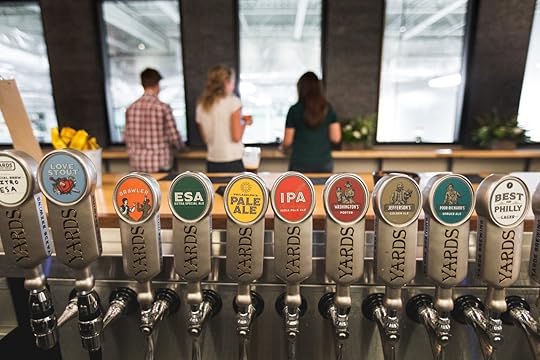
There’s no doubt that Philadelphia is a beer city. There are microbreweries and craft beer bars in every nook and cranny of Philly’s neighborhoods, and some corner stores pack fridges with better selections than proper liquor stores. Sure, the dive bars have plenty of PBRs, but they also carry rare seasonal beers on a rotating craft list.
There’s a long history to it all, this being Philadelphia. Over the course of the 19th century, Philadelphia and the surrounding area became a hub for brewers. At its peak, there were more than 90 breweries in operation in the city. Philadelphians spent many decades beer-drunk and merry until Prohibition brought the industry to a grinding halt. It took decades for Philly’s brewery scene to rebound after the Constitution was amended to once again allow alcohol.
In 1985, Dock Street Brewery opened and Philadelphia got its first craft brewery since Prohibition. Over time, the number of breweries in the city grew just as the number of breweries in the United States grew. Today, the craft beer scene in Philadelphia is one of the most diverse and exciting in the country. There is a stunning variety of breweries and styles, from classic lagers to the latest and greatest from the craft beer scene. It maintains its roots with nearby Yuengling — America’s oldest operating brewery — while also continuing to expand its mom-and-pop-type offerings seemingly every week.
We’ve rounded up six of the best breweries in the city to start off a proper Philadelphia craft beer sampling. Consider this list a jumping-off point, a dipping of the toe into the proverbial Philadelphia beer sea.
1. Wissahickon Brewery
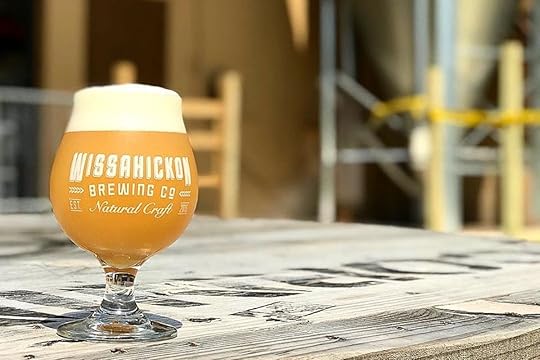
Photo: Wissahickon Brewing Company/Facebook
A bit outside of the city center, Philly turns a bit greener, a bit quieter, and a lot more in tune with the trends. The chill, friendly folks over at Wissahickon Brewery fit right into this scene. The space is packed on weekends with not only groups of hearty beer drinkers but also their babies, parents, and pets. It’s a welcoming brewery, the type you could go to by yourself and leave with a group of new friends.
The cozy vibe here is a big part of how Wissahickon operates. The brewery is family-owned and -operated, as well as community-oriented. There are weekly events, like yoga and quizzo, geared toward getting people together, and the haphazard way tables and benches are arranged encourages grouping up. A giant projector screen drops down for big games, and, of course, Wissahickon offers a nice rotating selection of drafts and brings around a food truck to feed the masses. It’s well worth a visit after a hike in nearby Wissahickon Park, even if that means rolling in with a dirty dog, an angry child, or both.
Where: 3705 W School House Ln, Philadelphia, PA 19129
2. Dock Street Brewery
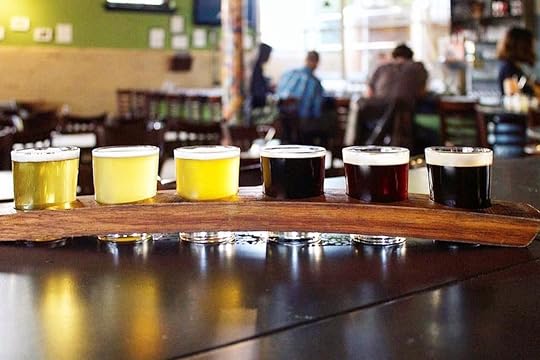
Photo: Dock Street Brewery/Facebook
Philly might be one of the country’s best beer cities now, but it wasn’t always that way. It became what it is today because of places like Dock Street Brewery, the first microbrewery to open its doors back in 1985. Here, the brewing experience shows.
The original location in West Philly is on the first floor of a firehouse, but the years have been good to Dock Street. It has since expanded into the space next door with the Dock Street Cannery and Tasting lounge, a hip new craft cocktail bar with inventive food. More recently, it opened up a new location in the Point Breeze neighborhood. Both of the brewery locations offer up delicious brews for a whopping $3.50 during happy hour.
Where: Original location at 701 S 50th St, Philadelphia, PA 19143 and Point Breeze location at 2118 Washington Ave, Philadelphia, PA 19146
3. Second District Brewpub
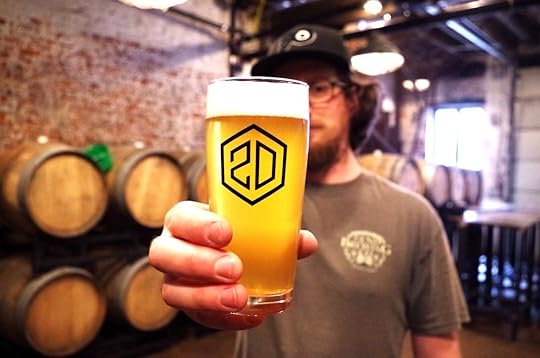
Photo: Second District Brewing/Facebook
The area surrounding Passyunk Avenue in South Philly has transformed into one of the best places to eat and drink in the city. It’s where the young chefs go, opening up restaurants that quickly gain cult-like followings for things like new takes on bao buns or expertly done renditions of the classic Jewish bakery. It’s also where some folks are brewing some very good beer.
Enter Second District Brewpub. Sharing the industrial-style interior found in many of the country’s breweries, Second District somehow maintains a cozier vibe. It’s the kind of place where you go for a beer and stay for seven (ideally lower percentage ones as the night goes on). It doesn’t hurt that Second District also offers up a great food menu, part of which is vegan and vegetarian.
Where: 1939 S Bancroft St, Philadelphia, PA 19145
4. Yards Brewing Company
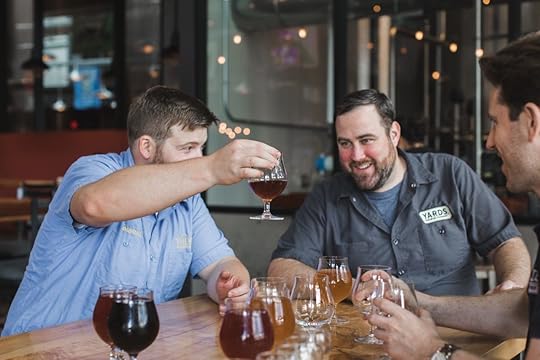
Photo: Yards Brewing Co./Facebook
Yards is the brewery that even the mildest of beer nerds have likely heard of. This is certainly not a microbrewery, but that doesn’t take away from the fact that Yards make a damn good beer. Yards is the largest brewery in Philadelphia and was started by homebrewers in a city garage in 1994. It’s earned the respect of locals thanks to choosing to remain in city limits when its success meant it could have easily moved to a larger location somewhere in the suburbs.
The brewery’s latest expansion landed the brewery in a giant hall in the middle of Northern Liberties. The inside is a huge, open room stuffed with long communal tables, making it the best brewery to go to with a large group. It has the feel of a German biergarten but with an upscale menu. Pricey food aside, this is a party spot. The nights are fun and loud, likely a product of happy guests consuming large quantities of the latest beer options. If you’re more interested in the history and science side, Yards also offers tours twice a day for $10 per person.
Where: 500 Spring Garden St, Philadelphia, PA 19123
5. Love City Brewery
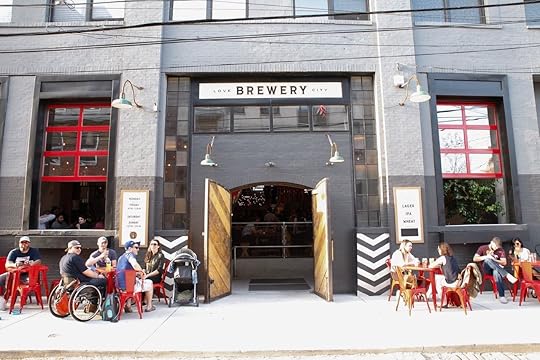
Photo: Love City Brewing Company/Facebook
The story of Love City Brewery is, perhaps unsurprisingly, a love story. Owners Kevin and Melissa started brewing together before they married, and then continued brewing together at their very own brewery. This is the spot to bring your friends who still think Philly is lame. The roughly 6,000-square-foot, newly opened brewpub is decked out in all the Insta-worthy decor your millennial friends can handle. Ask the bartender to pour one of the unpretentious beers into a glass, set it next to the small potted cactus, use the blue-tiled bar as a backdrop, and voila, you’re an influencer.
This doesn’t take away from the delicious beer, though. The classic Love City Lager is one of the most popular brews served in Philly. It makes an appearance on quite a few of the city’s taps, but none of those bars can boast serving it fewer than 100 feet from where it’s made.
Where: 1023 Hamilton St, Philadelphia, PA 19123
6. Evil Genius
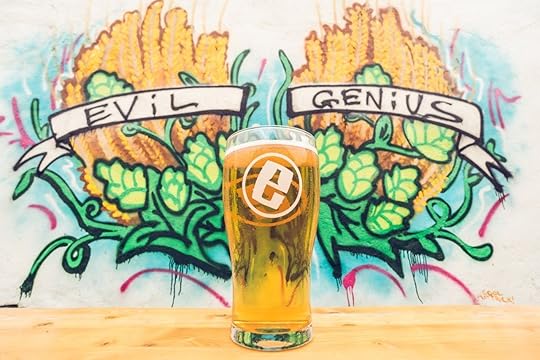
Photo: Evil Genius Beer Company/Facebook
Evil Genius has a bit of a cult following. It’s a spot for people in the know, and it’s one that is well worth getting to know. The best beers at Evil Genius are fun and funky, with twists of hops and dashes of citrus, herbs, or florals. Making your way through the extensive, rotating beer list is a little adventure in and of itself. The first sip is generally a bit of a surprise, maybe even a shock, but it leaves you curious. So you take another, and another, and before you know it you’ve completed this thrilling journey all the way to an empty glass. Then repeat.
Set in the heart of Fishtown, the space makes for a pretty standard brewpub, which is charming in its own right. The real hangout in the summer is the tucked aside outdoor space housing scattered tables lit by the gentle glow of overhead string lights.
Where: 1727 N Front St, Philadelphia, PA 19122 

More like this: The best bars in Philadelphia to drink at right now
The post The 6 breweries to visit on your first trip to Philly appeared first on Matador Network.

Drone footage of cities on lockdown
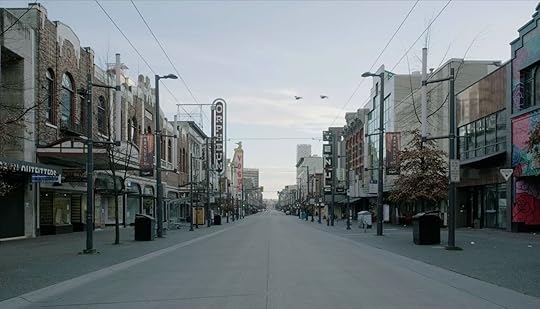
As the COVID-19 pandemic has caused life in cities around the world to grind to a halt, typically busy streets are empty, and the world’s most vibrant neighborhoods look like ghost towns.
But since we’re all staying inside, it can be difficult to really imagine how social distancing orders have changed our cities or know whether or not our personal efforts are followed by our neighbors.
Drones are uniquely equipped to capture environments from an illuminating perspective, showing us bird’s-eye views of city streets that truly give us a sense of the lockdown’s all-encompassing scale. From San Francisco to Cape Town, the videos below show a different, eerier side of your favorite cities.
San Francisco, California
From the usually bustling Columbus Avenue to Fisherman’s Wharf, San Francisco isn’t its typical lively self. All nonessential businesses have been closed in the city since March 17, and people are clearly taking social distancing recommendations seriously.
New York City, New York
The city that never sleeps has been asleep for weeks now, and it just feels downright bizarre. One of the world’s most popular destinations for tourism, New York is now almost unrecognizable, with Times Square, Rockefeller Center, and other iconic sites completely deserted.
Boston, Massachusetts
One of the United States’ oldest cities, Boston has been through a lot, though this might be the greatest challenge it’s ever faced. Red Sox fans are forced to stay away from Fenway Park this spring, and the city’s many world-class universities are empty.
Cape Town, South Africa
Cape Town, home to over 4.6 million inhabitants at the southern tip of Africa, is quieter than ever before. Even the beaches are completely vacant — an eerie scene, but a positive sign that South Africans are abiding by social distancing guidelines.
London, England
Crossing Tower Bridge or passing the London Eye without encountering hundreds of people was unheard of before the lockdown orders. Now, London is moving a little slower. From underground stations to the iconic Ferris wheel and Trafalgar Square, London looks sleepier than it ever has before.
Mumbai, India
Mumbai, one of the world’s busiest cities, especially when it comes to traffic, is taking on a whole new character right now. Since locking down on March 25, public transportation has been dramatically reduced, and the roads are almost entirely clear.
Chicago, Illinois
With most of Chicago’s most notable attractions closed to the public, the city looks like a ghost town. Footage of empty parks, streets, stadiums, and boardwalks paints an unusually quiet picture of the resilient city.
Vancouver, Canada
Footage of an empty Vancouver not only highlights the deserted Lions Gate Bridge, Olympic cauldron, and Burrard Bridge but also sheds light on inspiring murals and displays of support for healthcare workers.
Las Vegas, Nevada
If there’s one city we might imagine incapable of actually “locking down,” it’s probably Las Vegas. Though often unbound by the rules that govern more conventional cities, even Vegas isn’t immune to the pandemic. Casinos, clubs, and hotels are closed, and its iconic Strip is unbelievably quiet.
Milan, Italy
The epicenter of the coronavirus in Europe, northern Italy was hit harder than almost anywhere in the world. As such, it makes sense that this footage of a highway near Milan shows just how desolate the roads have been. 

More like this: Drone footage of San Francisco captures an eerie, empty city
The post Drone footage of cities around the world shows the extent of the stay-at-home restrictions appeared first on Matador Network.

Self-isolating on uninhabited isle

Everyone is self-isolating differently, and this former British paratrooper might have the most unique social distancing setup we’ve seen yet.
Chris Lewis left his home in Wales, in August 2017, embarking on a fundraising challenge to walk along the entire coastline of the United Kingdom to raise money for the SSAFA, Armed Forces Charity. He and his dog Jet have walked 12,000 miles and were sleeping in a tent on mainland Shetland when the UK’s lockdown restrictions went into effect on March 23. Since then, he has been given special permission to live in the only house on the uninhabited Shetland island of Hildasay.
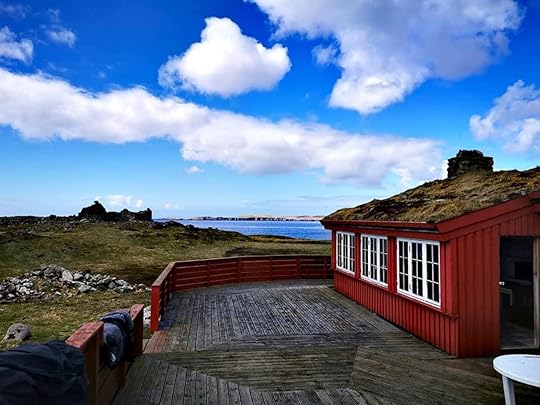
Photo: Chris Walks the UK/Facebook
The house is a former shepherd’s hut without running water, heat, or electricity, and he was generously offered the keys by the owner’s family once they learned about his situation. Lewis forages and fishes for food, collects driftwood, and survives on a regular shipment of fresh water and coal from the mainland.
“I’ve mainly been in isolation for the past two years,” he said, “due to the nature of the places we’ve been walking. When I heard there was going to be a lockdown, I was kindly given a boat to get over to Hildasay, which is an uninhabited island. I thought it would be better if I wasn’t on the mainland — I didn’t want to be in the way.”
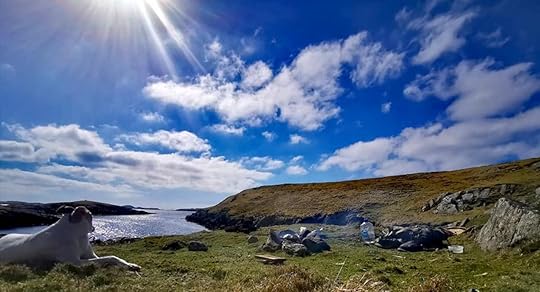
Photo: Chris Walks the UK/Facebook
Far from letting his new living situation dampen his spirits, Lewis says he’s actually very pleased with the situation.
“It has really given me a chance to enjoy the island. I’m able to reflect on the walk so far, just realizing what this has done to help me personally and the amount of amazing people there are in the UK. I’m the happiest I’ve ever been.”
Once the lockdown is lifted, Lewis will continue his walk north before heading back down the east coast. So far, he has raised £112,055, or almost $140,000. 

More like this: How to plan an island-hopping adventure through Scotland
The post This ex-soldier and his dog are self-isolating on an uninhabited Scottish island appeared first on Matador Network.

Lake Charles, Louisiana, travel
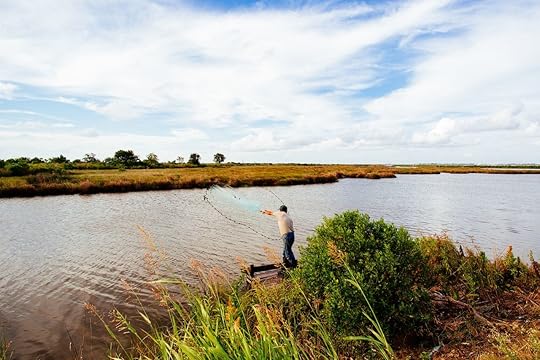
While Louisiana will always be synonymous with New Orleans, another city in the state holds its own in offering a heck of a good time. Lake Charles is a fun city with a chill vibe — in that you can still enjoy a night out with others but also remember what your evening was all about, unlike what usually happens on Bourbon Street. Dining options range from places with a focus on the menu and dishes, with little fuss over ambience, to longtime establishments that encourage you to dress up. Other eateries get creative with their takes on everyday dishes or special treats. There’s some culture and nature to take in, too, making it the perfect spot for a summer road trip. Here’s where to see in and around Lake Charles.
Lake Charles throws the state’s second-largest Mardi Gras.
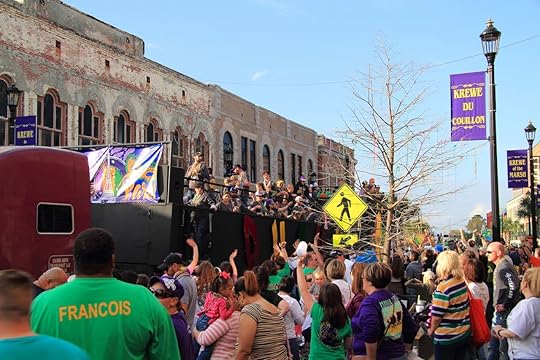
Photo: William Silver/Shutterstock
Three hours from NOLA, this city of 80,000 in Southwest Louisiana in the Calcasieu Parish puts on a big Mardi Gras, often said to be the state’s second-largest. Lake Charles not only hosts a grand parade but also has a children’s version and a royal gala where the town’s 60 krewes (social clubs that organize Mardi Gras events) put on their pageantry finest.
Some krewes also continue the Cajun tradition of a chicken run, known as a Courir de Mardi Gras. On Fat Tuesday, men in costume venture to different places and homes to perform music in exchange for receiving ingredients to make a community-feeding gumbo. The actual chicken run portion has the group’s captain release a live fowl, and youngsters chase after it to catch it.
Yet Lake Charles is active before and after Mardi Gras. The city is an event magnet with a yearlong activity calendar of more than 75 festivals that highlight such celebratory items of revelry including foods or holidays.
There are enough local distilleries and breweries to keep you very busy.
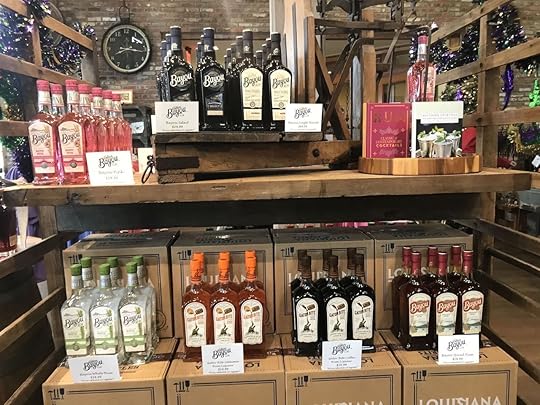
Photo: Michele Herrmann
Festival or not, the best way to experience the city is through its obsession with food and locally made spirits. Louisiana’s rum-making history dates back to America’s colonial era when Jesuits grew sugar cane to make tafia (a drink similar to rum) in the mid-18th century. A hundred years later, the end of the American Civil War would change Louisiana’s rum-making production — as enslaved labor had previously harvested sugar cane on plantations — and then in 1920, Prohibition would cease public distilling around the country.
In recent decades, Louisiana’s rum production has come back as a craft industry. Louisiana Spirits Distillery in Lacassine began producing its Bayou Rum with 21st-century technology, aging the spirit in sherry and bourbon casks. About 25 minutes from Lake Charles, the distillery makes six Bayou Rum labels that can be sampled at daily tastings within its Barrel Library & Event Center. Along with a brief tour of the production facility, regular and premium rum tastings can involve the Bayou Pink, an onsite-only rum whose color comes from mayhaw berries; Bayou Spiced Rum, which contains 32 baking spices; and Bayou Satsuma Rum Liqueur, which holds the juice of this seedless citrus.
Fifteen minutes west of town, take a tour of Yellowfin Distillery in Sulphur, which produces single-estate vodkas — meaning the spirit is produced using ingredients mostly or only sourced from a specific place (Louisiana cane sugar) and produced at one certain location (in this case, this distillery). What really makes the fermentation, distillation, and filtration process unique, though, is that it leaves zero residual sugar.
Being that this is 21st-century America, you can wash down (or substitute) these spirits with local beer. Crying Eagle Brewing Company is known for its four year-round beers — Pistol Bridge, Louisiana Lager, Ready to Mingle, and Hop Blooded IPA — plus rotating seasonal releases including Strawberry Rye. With an outdoor beer garden, taproom, and bistro, Crying Eagle holds tours on Fridays and Saturdays. Also in Lake Charles, Rikenjaks Brewing Company originally came about in 1992 and has established itself as a social club of sorts, featuring live music and theme nights.
It’s full of places serving Cajun favorites.
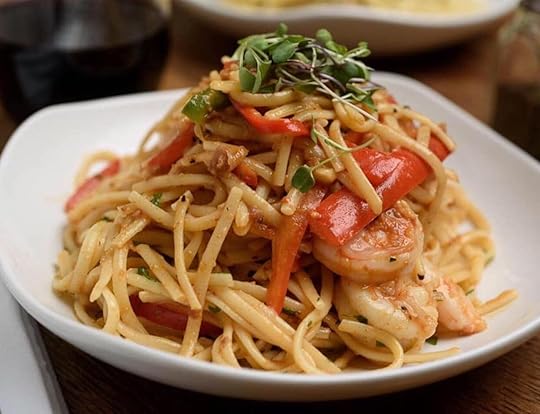
Photo: The Villa Harlequin/Facebook
Dress up or down to dine out — Lake Charles can suit many tastes. The Villa Harlequin is the merger of two longtime Lake Charles establishments — one being an Italian restaurant, the other a steak and seafood eatery — that has become a fusion of two family-run legacies. Its Creole tomato bisque with basil and crab is perhaps the unofficial dish of the city, highlighting not only Lousiana’s Creole legacy but also the town’s penchant for tapping into what’s provided by the surrounding land and waters.
If crawfish is what you’re craving, the Seafood Palace serves up boils of it and crab along with a noted gumbo and fried or grilled seafood platters. This place has the no-frills and low-key atmosphere ideal for pulling off shells.
For a night out, Luna Bar & Grill gives off a downtown music vibe with cocktails named after the Beatles and other famous musical acts. BOOMBOX Frozen Pops and Ice Cream recalls the 1980s in creating and naming its flavorful frozen treats, such as 99 Red Doubloons and the chocolate and coconut concoction Grass Monkey.
It’s the best spot in Louisiana to try boudin.

Photo: JVV Photography/Shutterstock
As engaging as pulling shells from fresh seafood is, it’s the boudin that actually defines Lake Charles’s cuisine. A specialty within the southern part of Louisiana, boudin is a finger food that’s the subject of its own trail running through Lake Charles and neighboring communities of Iowa, Sulphur, Vinton, Cameron Parish, and Westlake/Moss Bluff. This sausage snack, pronounced as “boodan,” is comprised of pork, liver, rice, onions, parsley, and dry seasonings. Find it at mom-and-pop establishments and restaurants such as LeBleu’s Landing and Sausage Link in Sulphur, a meat market with a window in which you can watch the stuff being made.
Beyond food, Lake Charles will teach you a thing or two about Louisiana culture.
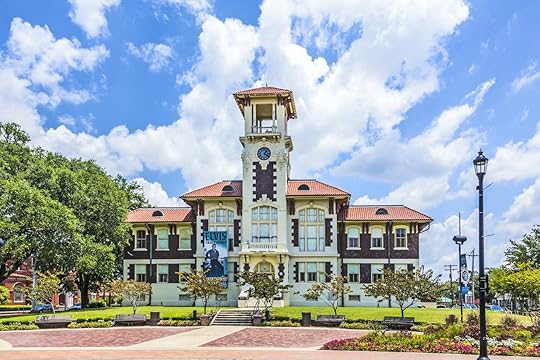
Photo: travelview/Shutterstock
Even if Mardi Gras has come and gone before a trip to Lake Charles, experience the festivities through a visit to the Mardi Gras Museum of Imperial Calcasieu. Located inside the Central School Arts and Humanities Building, this museum chronicles the holiday’s history in Lake Charles with around 290 Mardi Gras costumes on display — plus 300 more in storage — with placards explaining just about every facet of the celebration. Each room focuses on different aspects of Mardi Gras with the first one delving into its origins and others highlighting its colorful attire, parades and floats, and more. Along the way, encounter some animatronic figures sharing stories.
The 1911 History City Hall Arts and Cultural Center is the city’s public art gallery, with its two floors with different showings. The second floor hosts traveling exhibits — examples have involved one on the life of JFK that features a photo of him during his 1959 Lake Charles visit — while the first floor showcases work correlating to or by artists from Lake Charles.
There are also four casinos in or near Lake Charles, a staple of regional entertainment and the best place to overnight in town. L’Auberge Casino Resort has various guestrooms and suites, though the Isle of Capri Casino & Hotel is the spot for serious gamers with 30 gaming tables, 11 poker tables, and 1,100 slot and video poker machines.
Learn everything you need to know about the region’s nature and wildlife on the Creole Nature Trail.

Photo: Michael Kaercher/Shutterstock
Nicknamed Louisiana’s Outback, the Creole Nature Trail is a 180-mile All-American Road scenic byway venturing along marshlands, three wildlife reserves, and Gulf of Mexico beaches. It meanders to and from Lake Charles to Sulphur and is home to alligators and 400 bird species, with the latter making it one of top birding destinations in the country.
Start off your road trip from the Creole Nature Trail Adventure Point in Sulphur, which serves a resource center for finding maps and advice along with hands-on exhibits highlighting the region’s ties to wildlife, Cajun and Creole cuisine, and zydeco and Cajun music. Or, download the Creole Nature Trail app on iOS or Google Play and drive on. Learn more about the region’s gator population by interacting with them at Gator Chateau, a volunteer-run center in Jennings that provides a safe haven for rescued young alligators until they are able to be released into the wild. 

More like this: You haven’t experienced Louisiana’s Cajun Bayou until you’ve eaten your way through it
The post Craft spirits and Creole favorites make Lake Charles, Louisiana, the South’s summer hub appeared first on Matador Network.

Outstanding photographs of cross fox
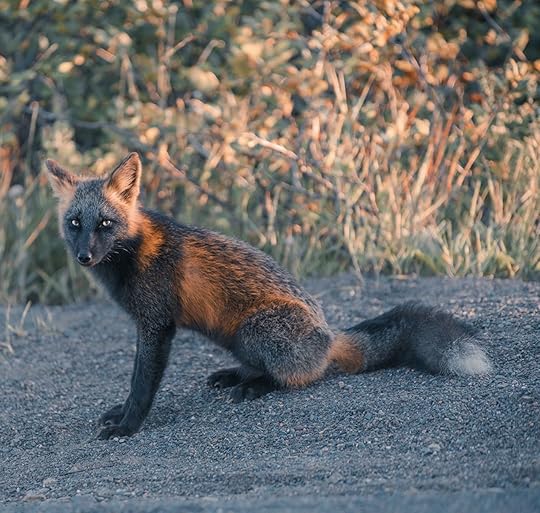
The animal kingdom never ceases to surprise us. From hybrid marine mammals like the narluga to the unique pink manta ray recently spotted off the coast of Australia, there’s no telling what fascinating curiosity wildlife-watching will throw at us next. Even the best-known species have secrets of their own that regularly knock our socks off.
This stunning fox is a prime example. A melanistic variety of the commonly spotted red fox, sporting a magnificent red and black coat and a white-tipped tail, was spotted by talented amateur photographer Sam Gaby in Newfoundland, Canada.
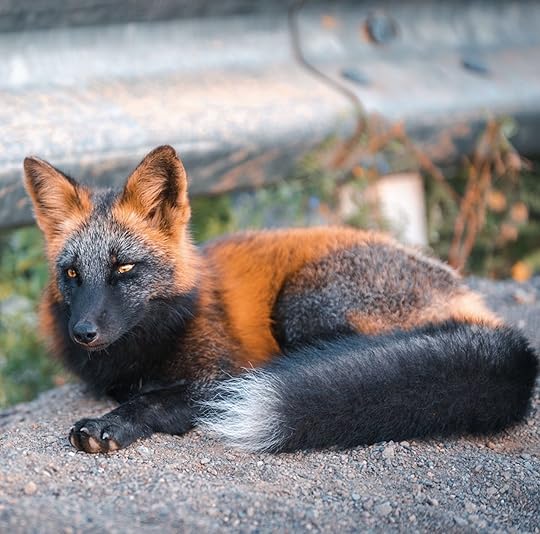
Photo: Sam Gaby/Instagram
The coloring of the animal is unlike anything you’d expect, with a long dark stripe running down its back, crossing another stripe to form a cross over its shoulders. Fittingly, this variety is called the cross fox.
Gaby — an economist, policy adviser, and photographer — captured photos of the fox in the small town of Twillingate in Newfoundland. After spending weeks trying to accustom the animals to his presence, he was able to be close enough to capture these incredible shots.
“I actually lack words to describe the encounter,” Gaby told Matador Network. “It was very personal to interact with this fox almost every day. One thing struck me — how intelligent these creatures are. If I had to describe them it would be a fox’s exterior with a cat’s interior.”

Photo: Sam Gaby/Instagram
Red foxes, the species to which the cross fox belongs, is common all over the northern hemisphere and is very abundant, but spotting a cross fox and being able to take such beautiful pictures of it is still an achievement.

Photo: Sam Gaby/Instagram
“The encounter was surreal,” Gaby told Bored Panda. “I spent almost eight weeks with these foxes, photographing them almost every day. As you can see, the foxes look very relaxed, with no sign of stress on their faces.” 

More like this: 8 tips for taking amazing wildlife photos
The post Amateur photographer captures extraordinary shots of a cross fox in Canada appeared first on Matador Network.

Jacksonville, Florida, reopens beach
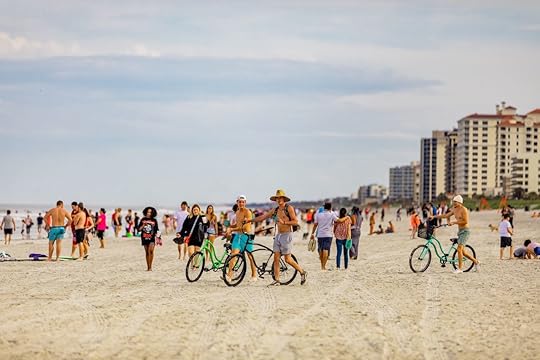
If anyone was going to take the national shaming stick for opening up too early, it might as well be Florida.
We’re used to being the United States’ poster child of stupid, the big, dangling punchline at the end of the country everyone uses to make their states feel smarter. It’s okay. We’re used to it. Bad judgment is as much a part of our identities as suntans.
So when Jacksonville announced it was opening its beaches at 5:00 PM Friday, the world was just waiting for us to Florida it up.
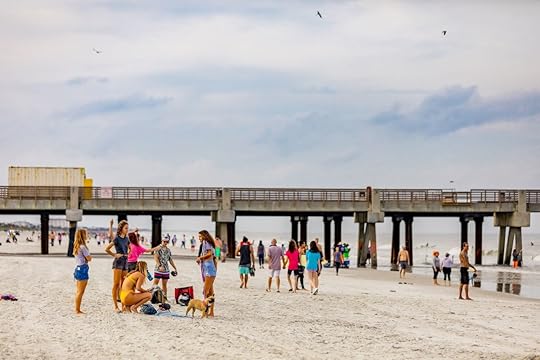
Photo: Laura Grier
#FloridaMorons began trending on Twitter. The US’ new legion of amateur epidemiologists predicted we’d be the forefront of the second wave. It was like we’d already ruined this grand experiment before it had even started.
That’s why it came as no surprise to me when the headlines and videos Saturday morning made it look like Spring Break had started back up again in Jacksonville. Camera angles made the sands of Duval County look like a pre-COVID New York City.
Few of those people bothered staying through the weekend.

Photo: Laura Grier
I arrived in Jacksonville on Saturday, a day after that prison break first evening. The beaches were full of people, yes, but they kept their distance from those outside their immediate circle. They weren’t setting up tents and throwing twilight beach raves. With a few exceptions, everyone was following the rules, using the beach for exercise and recreation and not as a place to party.
Collectively, it seemed Jacksonville understood that if they were going to be the models for other cities to be let back outside, they better do it right. And while the beach had a lot more people on it than usual, spring break it most certainly was not.
In case anyone was confused, signs throughout Jacksonville’s beaches reminded people to keep six feet of distance. They also reminded everyone of the new rules for beachgoing: No coolers, no blankets, no sunbathing. The beach was open for recreation only, so you had to be doing something — walking your dog, taking a stroll, swimming, surfing, fishing for mahi.
In front of a beachfront condo building, a couple was playing bocce ball with their pet husky.
“Everyone has been really respectful and following the rules,” said Nina Rothstein, a PhD student from Philadelphia who’s been staying in her parents’ condo overlooking the beach for three weeks. “The beach community isn’t as touristy here, so people have been rule-following, not pushing the limits.”
Rothstein has an autoimmune condition and came down to Florida three weeks ago as sitting inside her apartment in densely packed Philadelphia was not her idea of health. She says she’s had no issues since coming to Florida.
“It’s important not to induce claustrophobia,” said her partner and fellow PhD student Jan Thomas, as he tossed a bocce ball towards the ocean. “It felt nice to finally see people walking around. It’s less apocalyptic.”
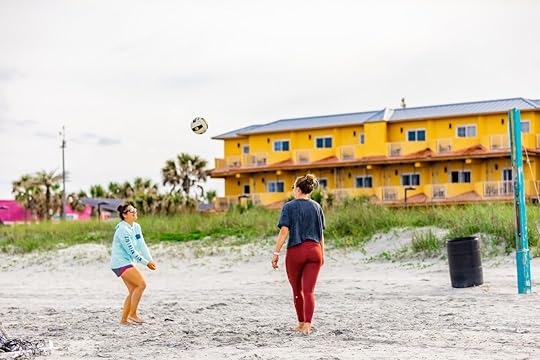
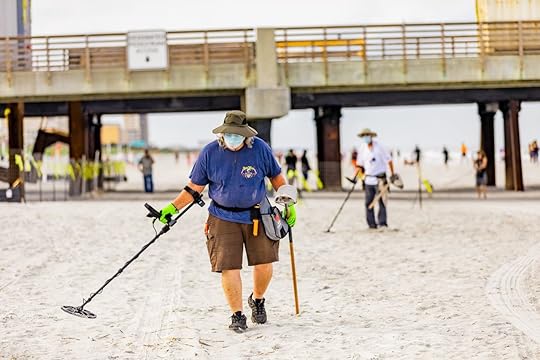
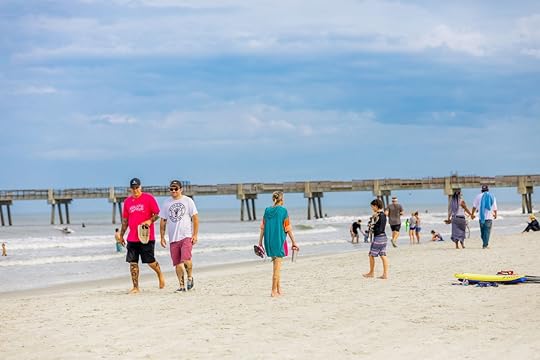
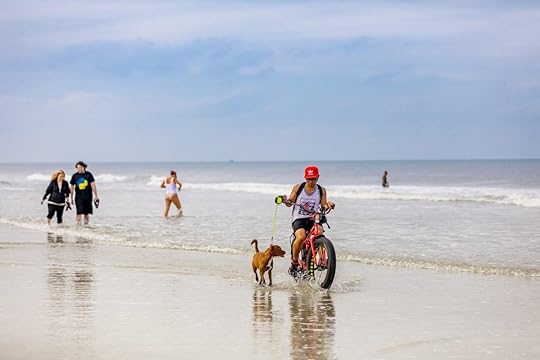




That aspect of positive mental health and wellbeing is one I hadn’t heard mentioned much among the masses criticizing Florida. But even on a slightly overcast afternoon, simply having a beach to go to brought a wave of sunshine over what’s been a pretty gloomy spring.
“After being on the front lines all week, it’s nice to get out,” said Jermey Thomas, a hospital worker from Lake City, Florida, as the smoke from his Black & Mild wafted in the ocean breeze. “We just gotta get out to a normal life.”
Thomas echoed what many here felt: That while it might be viewed as risky, getting people outside, exercising, and enjoying ocean air was crucial to mental health too.
But not everyone in Duval was sold on opening up early.
“I love the beach as much as anyone,” said a young man who seemed a little uncomfortable with his three friends standing within inches of him. “But, ya know, I don’t wanna die. I think they should’ve stayed closed. What’s the difference if we wait a few weeks? That’s not gonna save the economy.”
“I don’t know,” a young lady in a pink bikini standing next to him disagreed, as she took a sip from a large Styrofoam cup. “In Duval we’ve got, what, a million people? And only have like 750 cases?”
Next to her another man in a Go Noles! shirt put his arms around them to take a group picture. While most people in Jacksonville were following the rules, there are always exceptions.
Jax Beach shows it will be a slow return to the old days.
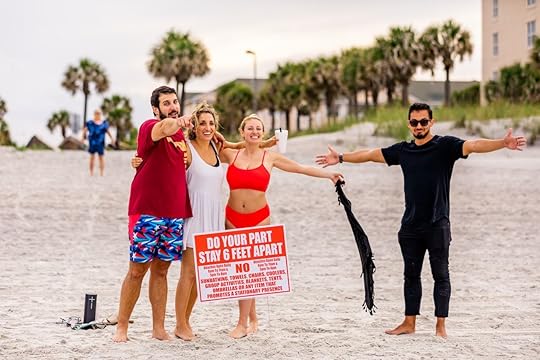
Photo: Laura Grier
In the ocean surfers, who’ve understood the importance of keeping appropriate distances since they picked up a surfboard, spun and twirled and shredded waves like they were visiting a long-lost friend. Couples walked together. Parents yelled at their kids not to get out too far. Everyone was smiling. Finally, it felt like the beach, but somehow, it wasn’t the beach.
The beaches were only open from 6:00 to 11:00 AM and 5:00 to 8:00 PM. Police patrolled the sand the entire time, ensuring nobody was breaking the rules. They were polite, and sometimes funny, yelling over the speaker, “The closer we get, the worse it is for you.” But you still felt watched. It was a little like Jacksonville had been let out for recess: Go outside and play, but don’t have too much fun.
This felt true throughout the entire city, where you didn’t have to wear a mask and the beach was open but bars and restaurants still were not.
My post-beach beer at Hoptinger came with a lid and a straw. My dinner at Orsay came plated in Styrofoam containers and had to survive the 30-minute drive back to my hotel.
“I miss plating things,” Chef Jonathan Insetta told me as he handed me my to-go bags. The food was still delicious, but I wasn’t able to replicate the presentation on Hampton Inn breakfast plates.
Jacksonville felt more normal than most of the world does right now, but it still wasn’t a complete return to “the great before.” But through all the talk and pontificating about what everything will look like once we’re out from under the blanket of COVID-19, Jacksonville may at least give us our first real glimpse of what the new normal might be.
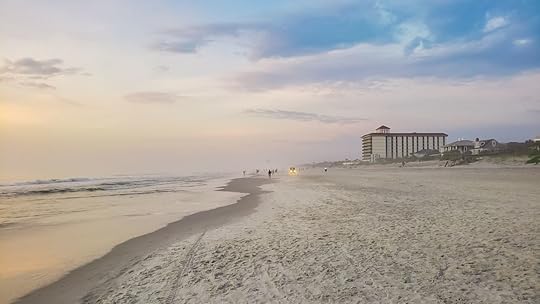
Photo: Laura Grier
We won’t be able to have Sunday Funday at the beach, or cram ourselves into restaurants and bars. But if we can — I can’t believe I’m saying this — follow (most of) Florida’s lead and act responsibly, we can get back to doing some of the things we enjoy, and maybe get people back to work in the process. And though it may make people feel good to call us all #FloridaMorons, they’ll soon learn a day at the beach, with responsible social distancing, feels a lot better. 

More like this: Your questions about exercising outside while social distancing, answered
The post Jacksonville opened its beaches this weekend, and it may be a look at America’s new normal appeared first on Matador Network.

Cocktail bars in Panama City, Panama

If you’re looking for a place to get away from it all with a drink in hand, consider adding Panama City to your travel bucket list. Residents of the capital city of Panama have a bright outlook on life, and the perennial happy hour and bustling cocktail scene certainly helps. There’s no denying that Panameños are drinking in the good life. Here, you’ll find fine-crafted cocktails — made with ingredients ranging from classic to the more experimental — savored in paradisiacal quarters.
These are the best cocktail bars (including rooftop cocktail bars) in Panama City to quench your cocktail thirst.
1. Tantalo

Photo: Tantalo Hotel Kitchen Rooftop/Facebook
Sip drinks under the string lights of Panama City’s most popular rooftop bar. Tantalo is more than a loved part of Casco Viejo’s rooftop scene — it practically created it. Casco Viejo (also known as Casco Antiguo or San Felipe) was once an off-limits district complete with a street called salsipuedes (“get out if you can”). It has since ripened into the entertainment enclave of all of Panama City, with a gaggle of glittering rooftop lounges. Tantalo is part of the eponymous 10-room boutique hotel, and there’s another restaurant and bar on the ground floor. The large-scale murals are transfixing, and in the evenings, the ground floor lavatory could be mistaken for a dizzying VIP room backstage at a Zedd gig. You can’t go wrong with the maracuya (passion fruit) mojito, and if you like piña coladas, you won’t regret ordering one here.
Where: Calle 8 Este con Avenida B
2. Stranger’s Club

Photo: The Strangers Club/Facebook
The classy Stranger’s Club comes to the old town of Casco Viejo from the founders of New York City’s Employees Only. The decor harkens back to ‘50s Havana, and concoctions with local ingredients like Panama’s aji chombo peppers and seco, the country’s national liquor. Raise your spirits with the Q’Xopa cocktail of kaffir-lime-infused seco and fresh lime juice. One of Panama’s linguistic traits is changing the order of words — for instance, que pasó? (“what’s up?”) becomes que xopa? (keh-soh-pa), the name of this delectable cocktail. Set over two dim-lit floors, Stranger’s Club is cozy, intimate, and it goes further than pretty umbrella drinks (although the mai tai isn’t to be missed).
Where: Calle B y Avenida Central
3. Pedro Mandinga

Photo: Pedro Mandinga Rum/Facebook
Pedro Mandinga is a cocktail lounge Don Draper would love. Panama’s first craft rum distillery in Casco Viejo has wooden walls, floral upholstery, and hard-working ceiling fans to cool you down from the famed Panamanian heat. Pedro Mandinga’s award-winning rums are produced in the Panamanian province of Chiriquí with raspadura pure cane sugar. The menu promises a waterfall of rum concoctions and creative Caribbean sharing plates to pair with your cocktail. The bar offers an extensive happy hour and a second branch recently opened in the Via Argentina neighborhood.
Where: Avenida A. entre Plaza Herrera y Calle 8A, Portal de Caldas
4. LOST Urban Beach Club
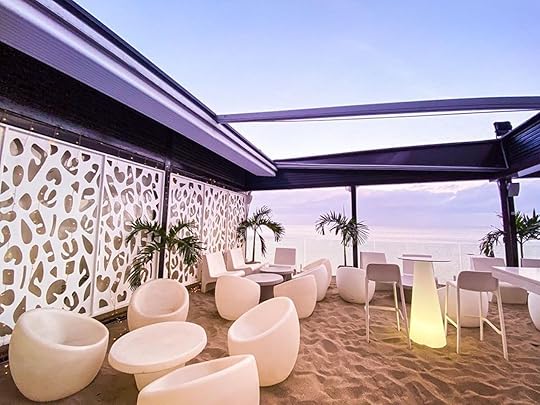
Photo: LOST Urban Beach Club/Facebook
Have a blue drink in the white sand at LOST. You’ll thirst for nothing here with a menu designed to impress even the staunchest cocktail aficionado, and the bartenders are very serious about gin. The Mare Nostrum cocktail with thyme ice cubes smells and feels like a whole world of friendly flavors in a glass. The mocktails are equally wondrous. LOST is tucked at the back of the JW Marriott on the banks of Panama Bay. A common misconception is that Panamá is a beach city, but it’s actually along a bay. Find your way to LOST for the only sandy experience within city limits.
Where: Calle Punta Colon, Punta Pacifica, Corregimiento de San Francisco
5. Salvaje
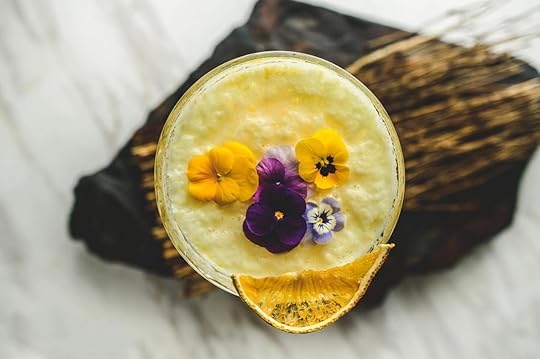
Photo: Salvaje Panama/Facebook
Salvaje is a photoshoot location masquerading as a bar. Many rooftops in Casco Viejo claim to have the best view in the area, but Salvaje is a particularly strong contender. Try the Vikingo, a splendid mix of gin infused with red fruits, almonds, and eucalyptus that is served in a faux tusk. The Holy Grail of the menu is the Indiana Jones, a cocktail of ginger beer, cucumber vodka, blackberry, and basil. And the cherry on top? It’s presented in an armored skull with horns for handles. Make the right decision and order one while you’re there. Let’s face it: Life feels good when you’re drinking cocktails in paradise.
Where: Avenida Eloy Alfaro esquina Calle 11
6. Joder Gastro Lab
Over in the San Francisco neighborhood, Joder Gastro Lab has everything from cotton candy cocktails (decoratively affixed to helium balloons) and homemade rum punch to bartenders wearing Salvador Dalí masks and red boiler suits à la Money Heist (the first episode of the popular Netflix show’s third season was shot in Panama). The food menu also draws inspiration from the Spanish surrealist. Get your hands on Las Esféras de Dali, lip-smacking goat’s cheese croquettes with manchego, unagi sauce, and guava. San Francisco is an upscale residential neighborhood with exciting eateries dotted all around. Don’t skip this one.
Where: Calle 77 diagonal a Atlapa 

More like this: How to take the ultimate coffee trip through Panama
The post The cocktail lover’s guide to Panama City, Panama appeared first on Matador Network.

How to help Earth Day 2020
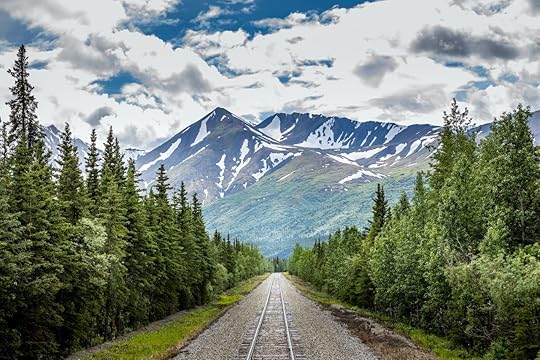
April 22 will be the 50th anniversary of Earth Day. Yet with the country focused on fighting the pandemic, the Trump administration is taking advantage of our collective distraction to roll back even more environmental protections. Social distancing means there won’t be big public protests this year — but there are still positive steps you can take to protect public lands, keep our air clean, and reduce emissions. A half century after the first Earth Day, there’s no time to waste. Here’s what you can do.
1. Urge your local leaders to maintain enforcement of emissions regulations.
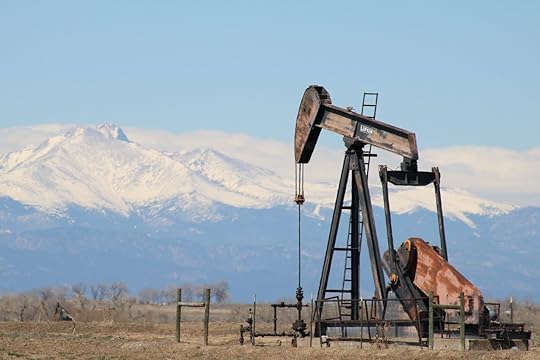
Photo: Rexjaymes/Shutterstock
On March 26, residents in states across the country were adjusting to life under lockdown. On that day, the Environmental Protection Agency (EPA) issued a release saying that it would ease enforcement of “civil violations” to federal emissions regulations during the COVID-19 outbreak. The news has been widely interpreted as the EPA turning a blind eye to companies looking to skirt environmental restrictions during the pandemic and has caused a stir among conservationists and many on the political left.
“This is a cruel paradox. The EPA is using an unprecedented public health crisis to justify allowing polluters to put our health at even greater risk — at a time when we most need their protection,” said Gina McCarthy, executive director of the Natural Resources Defense Council (NRDC), in a statement. Prior to her current role, McCarthy served as EPA director under former President Barack Obama.
For the NRDC and other advocates, concerns largely center on reduced federal oversight allowing oil and gas companies, as well as others operating on or near public lands, to relax internal protocols on land and water pollution. Matador Network spoke via email with Jared Knicley, an NRDC attorney who worked with his organization to ask the EPA to backtrack its stance and issue an emergency rule to protect public health.
“The key point for outdoor advocates is that the policy makes it harder for people enjoying the outdoors to know the lands and waters they are enjoying are safe from pollution,” Knicley writes. “Monitoring and reporting requirements are critical to the web of environmental laws that protect our air, land, and water. EPA’s policy opens the door for facilities to cease monitoring and reporting requirements during the pandemic, with no oversight to prevent abuse.”
“Without regular monitoring and public reporting, the public won’t know when and where pollution is occurring, potentially putting outdoor advocates (among others) at risk, without their knowledge,” adds Knickley. “For example, someone fishing downstream of a pollution source that fails to report a pollution limit violation, or someone running outdoors near a facility with unreported air emissions.”
What you can do
The best way to express your opinion on this is to write to your local Congressperson and ask that they push for the EPA to return enforcement protocol to normal, and that local enforcement continues at pre-COVID levels in your state. Should you notice potential compliance violations, you can report them here.
2. Stand against the Trump administration’s renewed push for Arctic drilling.

Photo: Kyle T Perry/Shutterstock
The federal government is pushing forward ConocoPhillips’ Willow project, which would significantly increase oil and gas development in the National Petroleum Reserve of northern Alaska. The project would threaten wildlife in the area as well as the livelihood of the nearby town of Nuiqsut, which uses the land for subsistence hunting. ConocoPhillips had originally planned to build an island to access the proposed drilling site, but after opposition from the village and elsewhere, has altered plans to develop a series of ice roads, according to a report by Alaska Public Media.
In its own master plan, the Bureau of Land Management concedes, “The BLM expects that limitations to subsistence access and the reduced resource availability attributable to development of the Project would result in an extensive interference with Nuiqsut hunter access.”
What you can do:
The Center for Biological Diversity is asking concerned citizens to sign this petition to the BLM.
Also, submit a comment before May 4, 2020, directly to the BLM. An Alaskan organization called the Northern Center compiled a list of talking points to address in your comment.
3. Support stricter auto emissions standards for new vehicles.
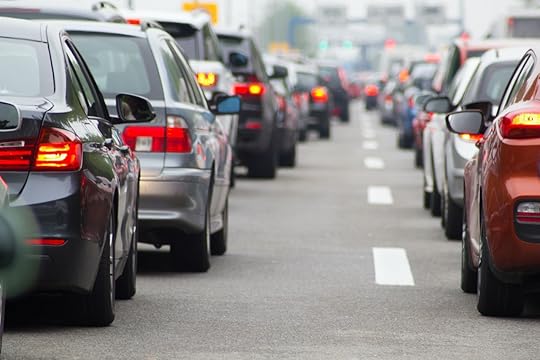
Photo: ddisq/Shutterstock
On March 31, the Trump administration finalized its rollbacks of Obama-era vehicle emissions standards, reducing the required annual carbon dioxide emissions reduction in new vehicles from 5 percent to 1.5 percent. The move reduces the burden on automakers to produce consistently cleaner vehicles. The US Senate’s Committee on Environmental and Public Works expressed concern that an additional one billion metric tons of greenhouse gas emissions could result from the rollbacks, which could also increase the cost of transportation for Americans who will have to visit the pump more often.
“Consumers want cleaner vehicles, vehicles that will go farther on a charge or a gallon of gas. These standards are so important, however, because they guarantee that consumers will be able to get the cleaner options they desire,” Luke Tonachel, the NRDC’s director of clean vehicles and fuels, told Matador.
“As the Trump administration’s own data shows, rolling back these standards is bad for our health and bad for our economy,” said Tonachel. “It will raise the cost of owning a vehicle; it will cut employment; it will lead to more toxic pollution; and it will undercut our efforts to address our climate crisis. Consumer preference is important, but we need these standards to ensure they have a range of better vehicles to choose from.”
What you can do:
The guidelines are finalized, meaning there aren’t petitions to sign or senators to hound to prevent its passage. But you can still vote with your choices. If you plan to buy a new car, consider a used or electric vehicle. And if you’re not in the auto market, ride your bike, walk, or find other methods of transportation whenever possible, including using public transit once social distancing measures are relaxed.
4. Sign a quick petition to keep public lands in public hands.

Photo: Zack Frank/Shutterstock
In October of last year, Matador reported on the BLM’s move to Grand Junction, Colorado, and the ongoing concern that acting director William Pendley plans to use the move to disassemble the bureau’s cohesive voice for public lands by removing top-level staff from Washington. Pendley has received immense pushback to the idea of putting vast swaths of federal public lands in the hands of states, and you can add your voice to the collective call for preservation by signing this quick petition from Outdoor Alliance.
5. Make Earth Day your everyday.
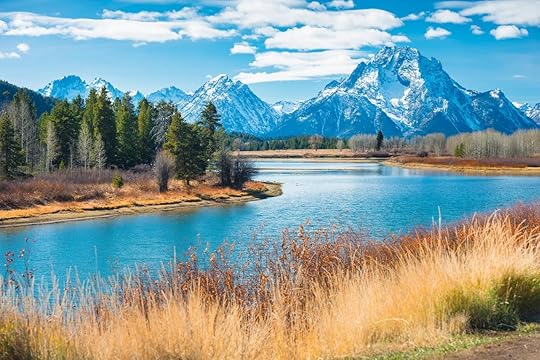
Photo: aphotostory/Shutterstock
The most important thing you can do, in a pandemic or another sudden and abrupt period of shock, is to stay your course. Reduce, reuse, and recycle, just like you always have. Pay for campsites even if there isn’t a ranger on duty. Get on your bike. Contact your reps. Stay informed, and have conversations with friends and family. Gina McCarthy said it best when addressing EPA employees fearful of serving under the Trump administration. Knowing the importance of their hard scientific data in fighting against regulation rollbacks, she spoke bluntly to her staff prior to ceding her position: “Keep your asses in your seats.” 

More like this: The Bureau of Land Management is moving to Colorado, and it could spell trouble for public lands
The post 5 quick actions you can take to protect public lands under attack this Earth Day appeared first on Matador Network.

Matador Network's Blog
- Matador Network's profile
- 6 followers



